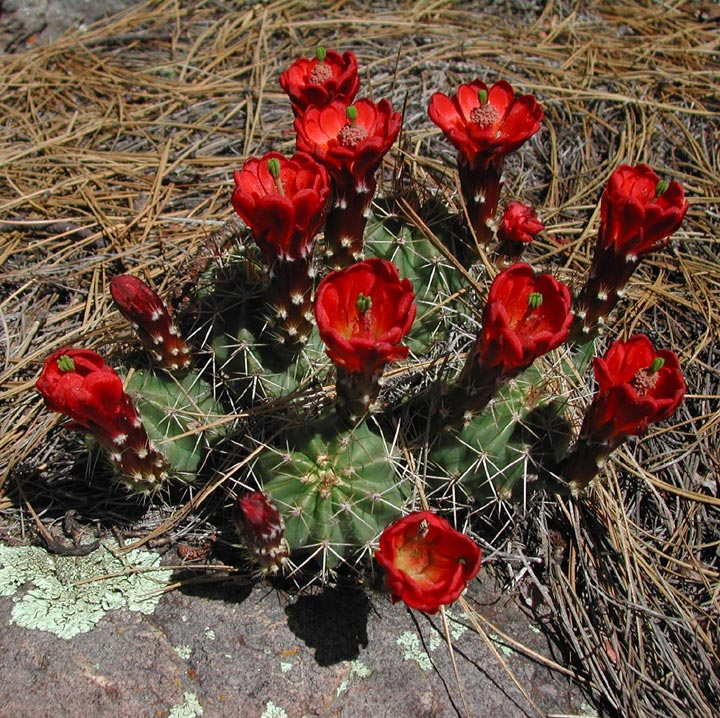Echinocereus
|
Family: Cactaceae |
Plants usually erect, ascending, sprawling, pendent, or decumbent, branched or unbranched, sometimes forming dense mounds to 500 branches, usually not deep-seated in substrate. Roots diffuse (usually a fascicle of several, tuberlike roots greatly exceeding stem diameter in E. poselgeri; sometimes adventitious in E. pentalophus). Stems unsegmented, yellow-green to dark green, spheric to long cylindric, sometimes tapering distally, (1-)2-70(-130)[-200] × (0.6-)1-15 cm, less than 40 cm at flowering, skin hard and brittle (less often soft), tuberculate (especially on immature plants) or ribbed; ribs 4-26, crests indistinctly to prominently undulate (irregularly notched or sharply folded if desiccated); areoles 1-52 mm apart along ribs, circular to linear, never completely confluent; cortex and pith soft, mucilaginous. Spines (0-)4-55 per areole, white, yellow, reddish, brown, or black, subulate or acicular to bristlelike, (0-)3-150 × 0.1-2.5 mm, hard, smooth or microscopically roughened (especially in E. triglochidiatus); radial spines (0-)4-38 (-45) per areole, straight or curved, sometimes pectinately arranged, (0-)2-40(-50) mm; central spines 0-17 per areole, straight, curved, or twisted, never hooked, terete, elliptic in cross section or variously angled to flattened. Flowers diurnal (a few species remaining open at night) [or nocturnal], bisexual (at least appearing so) or functionally unisexual, ± lateral on stem from year-old areoles (rarely terminal), broadly to narrowly funnelform or short tubular, 20-120 × (10-)15-150 mm; flower tube 5-26[-50] mm (measured from base of innermost tepals to base of nectar chamber); inner tepals pink, red, magenta, orange, yellow, brownish, or greenish (rarely white), proximally a darker or contrasting color or similar to distal portion; ovary smooth to tuberculate, scales usually minute, spines very prominent, areoles woolly; stigma lobes 5-22, green or yellowish green [rarely white or red]. Fruits indehiscent or dehiscent through short longitudinal slits, green, purplish brown, pink, or red, spheric to narrowly obovoid, usually 20-30 mm, juicy, drying quickly, scales minute; areoles spiny, spine clusters usually deciduous at maturity. Seeds black or dark reddish brown, spheric to obovoid, 0.8-2 mm, strongly tuberculate or rugose; testa cells strongly convex, sometimes irregularly confluent into ridges with interstitial pits. x = Echinocereus was treated as a distinct North American tribe Echinocereeae Buxbaum before recent chloroplast DNA analyses demonstrated that Echinocereus is nested within tribe Pachycereeae Buxbaum emend. A. C. Gibson & K. E. Horak, including the dominant columnar cacti of North America (R. S. Wallace and A. C. Gibson 2002). Whether Echinocereus and its closest relatives deserve recognition as a subtribe within the newly defined tribe awaits more extensive and intensive DNA investigations of all clades within the tribe. Many of the species of Echinocereus are confusingly polytypic, having geographic races (not all of them named), and many populations are polymorphic. One 'species' (E. pectinatus as circumscribed by L. D. Benson 1982) is polyphyletic. Although stem growth is indeterminate and branching is lateral, near their bases stems often shrivel and shorten more or less in pace with apical growth, pulling the branch-attachments down to ground level or below. The distance between areoles (interareolar distance), as employed here, is measured from centers of areoles along rib crests on relatively new growth, i.e., before ribs wrinkle. In some species, flower buds and stem-branch buds erupt through the epidermis of the stem adaxial to spine clusters, leaving a permanent scar; a condition referred to as 'erumpent.' The vernacular name strawberry cactus, used for several species, refers to the strawberry-like flavor of the ripe fruits, which are avidly harvested by human foragers. The largest and most sought-after fruits are those of Echinocereus stramineus. The key below will not work without flowers and/or fruits.
|

